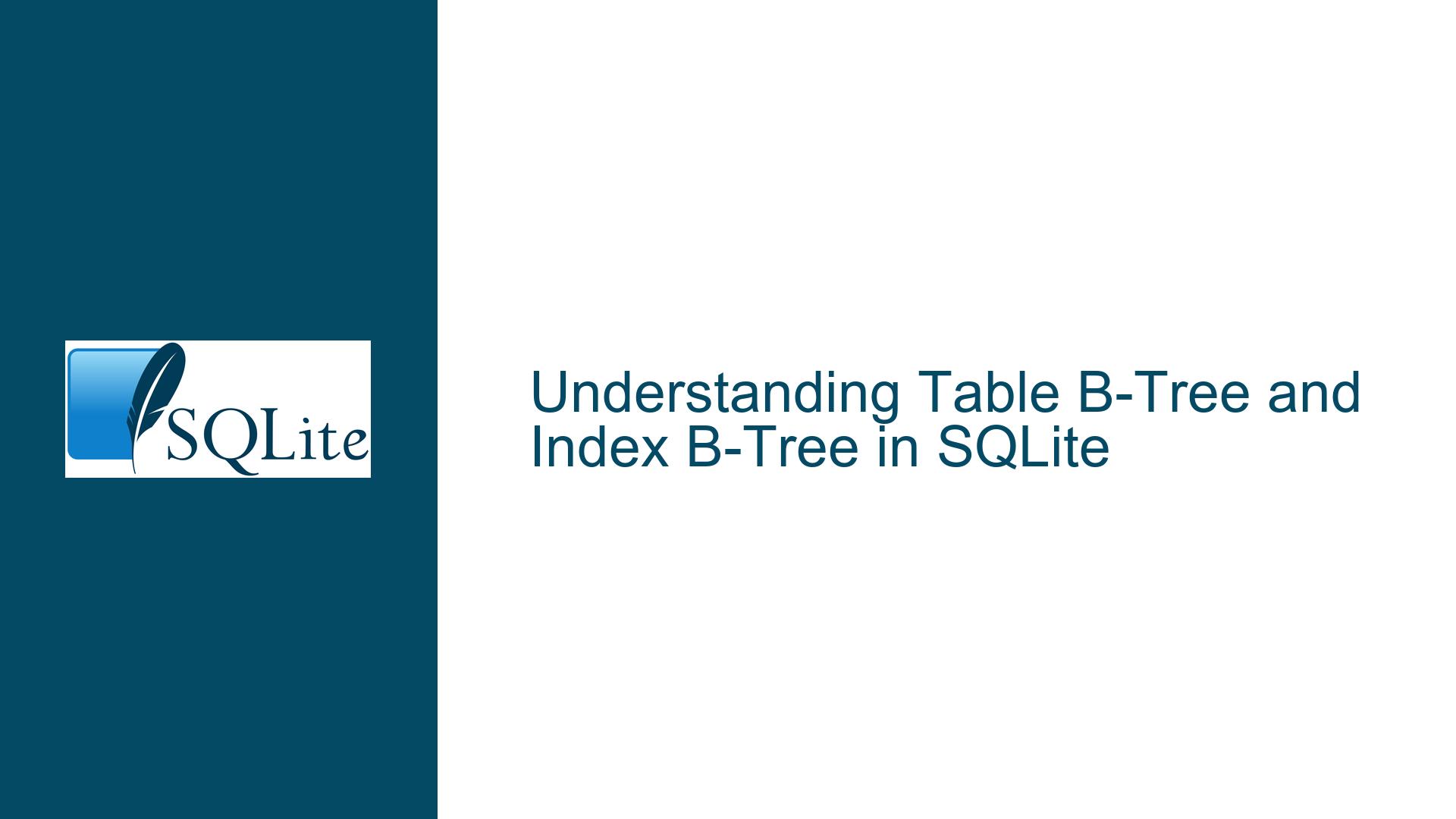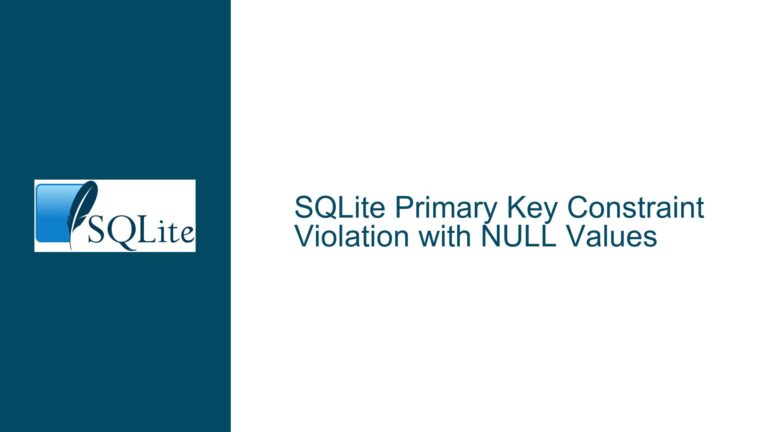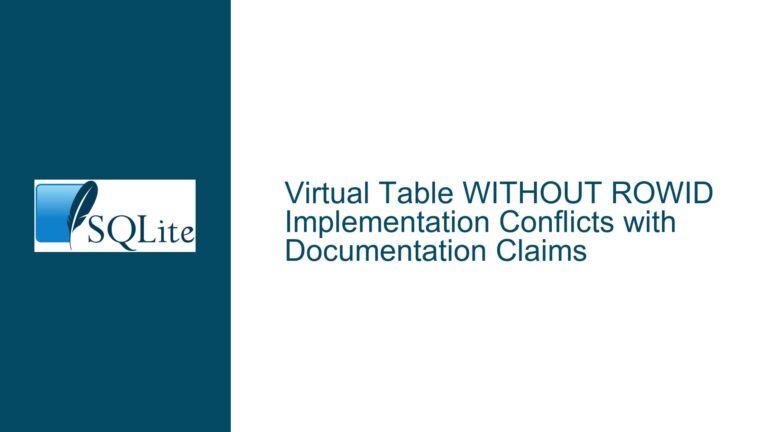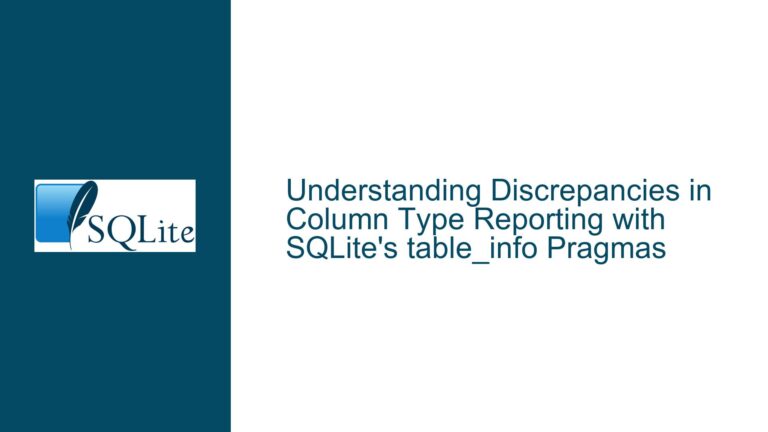Table B-Tree and Index B-Tree in SQLite
Table B-Tree and Index B-Tree: Core Differences and Use Cases
Issue Overview
In SQLite, the management of data structures is fundamentally based on B-Trees, which are hierarchical data structures that allow for efficient data retrieval, insertion, and deletion. SQLite employs two distinct types of B-Trees: Table B-Trees and Index B-Trees. Understanding the differences between these two types of B-Trees is crucial for database schema design, query optimization, and overall database performance.
A Table B-Tree is used to store the actual data rows of a table. Each row in a table is stored as a record in the Table B-Tree, and the tree is organized based on the rowid, which is a unique identifier for each row in the table. The rowid is automatically assigned by SQLite unless the table is explicitly defined as a "WITHOUT ROWID" table. In such cases, the table is stored using an Index B-Tree instead.
An Index B-Tree, on the other hand, is used to store index data. Indexes are created to speed up data retrieval operations by allowing the database to quickly locate rows based on the indexed columns. When you create an index on a table, SQLite creates an Index B-Tree that maps the indexed column values to the corresponding rowids. This allows the database to quickly find the rows that match a given query condition without having to scan the entire table.
The distinction between Table B-Trees and Index B-Trees becomes particularly important when considering the performance implications of different types of queries and the storage requirements of the database. For example, a query that retrieves data based on a primary key will typically be faster than a query that retrieves data based on a non-indexed column, because the primary key is stored in a Table B-Tree, which is optimized for fast lookups. On the other hand, a query that retrieves data based on a non-indexed column will require a full table scan, which can be much slower.
Possible Causes of Confusion and Misuse
One of the primary sources of confusion when working with Table B-Trees and Index B-Trees in SQLite is the distinction between rowid tables and "WITHOUT ROWID" tables. In a rowid table, the data is stored in a Table B-Tree, with the rowid serving as the primary key. This is the default behavior in SQLite, and it is generally the most efficient way to store data when the table has a simple structure and the primary key is a single column.
However, when a table is defined as a "WITHOUT ROWID" table, the data is stored in an Index B-Tree instead. This can be useful in certain scenarios, such as when the table has a composite primary key or when the primary key is a large or complex data type. In these cases, using an Index B-Tree can result in more efficient storage and faster query performance, because the database can use the index to quickly locate the rows that match a given query condition.
Another potential source of confusion is the use of indexes in SQLite. When you create an index on a table, SQLite creates an Index B-Tree that maps the indexed column values to the corresponding rowids. This allows the database to quickly find the rows that match a given query condition without having to scan the entire table. However, creating too many indexes can lead to increased storage requirements and slower write performance, because the database must update the indexes whenever the data in the table is modified.
Additionally, the use of virtual tables can complicate the understanding of Table B-Trees and Index B-Trees. Virtual tables are tables that are not stored in the database file but are instead implemented by a custom module. These tables do not have associated B-Trees, but they may use shadow tables for storage. Shadow tables are regular tables that are used internally by the virtual table implementation to store data. These shadow tables will have their own entries in the database schema and will use either Table B-Trees or Index B-Trees depending on their structure.
Troubleshooting Steps, Solutions & Fixes
To effectively troubleshoot issues related to Table B-Trees and Index B-Trees in SQLite, it is important to first understand the structure of the database schema and the types of queries that are being executed. This can be done by examining the database schema using the sqlite_schema table, which contains information about all the tables and indexes in the database. The sqlite_schema table itself is stored in a Table B-Tree, and its root page is always page 1 in the database file.
When analyzing the schema, pay particular attention to the types of tables and indexes that are present. For each table, determine whether it is a rowid table or a "WITHOUT ROWID" table. For each index, determine which columns are indexed and whether the index is unique. This information can be used to identify potential performance bottlenecks and to optimize the schema for better query performance.
If you encounter performance issues with a particular query, consider whether the query is using an index. You can use the EXPLAIN QUERY PLAN statement to see how SQLite is executing the query and whether it is using an index. If the query is not using an index, consider creating an index on the columns that are used in the query condition. However, be cautious about creating too many indexes, as this can lead to increased storage requirements and slower write performance.
In some cases, it may be necessary to restructure the database schema to improve performance. For example, if a table has a composite primary key and is frequently queried based on one of the columns in the primary key, consider creating a separate index on that column. This can allow the database to quickly locate the rows that match the query condition without having to scan the entire table.
If you are working with a "WITHOUT ROWID" table, be aware that the data is stored in an Index B-Tree rather than a Table B-Tree. This can have implications for query performance, particularly if the table has a large number of rows or if the primary key is a large or complex data type. In these cases, consider whether the benefits of using a "WITHOUT ROWID" table outweigh the potential performance trade-offs.
Finally, if you are working with virtual tables, be aware that these tables do not have associated B-Trees. Instead, they may use shadow tables for storage. These shadow tables will have their own entries in the database schema and will use either Table B-Trees or Index B-Trees depending on their structure. When troubleshooting issues with virtual tables, consider whether the issue is related to the virtual table implementation or to the underlying shadow tables.
In conclusion, understanding the differences between Table B-Trees and Index B-Trees in SQLite is essential for effective database schema design and query optimization. By carefully analyzing the database schema and the types of queries that are being executed, you can identify potential performance bottlenecks and take steps to optimize the schema for better query performance. Whether you are working with rowid tables, "WITHOUT ROWID" tables, or virtual tables, a thorough understanding of the underlying data structures will help you to build more efficient and performant databases.






